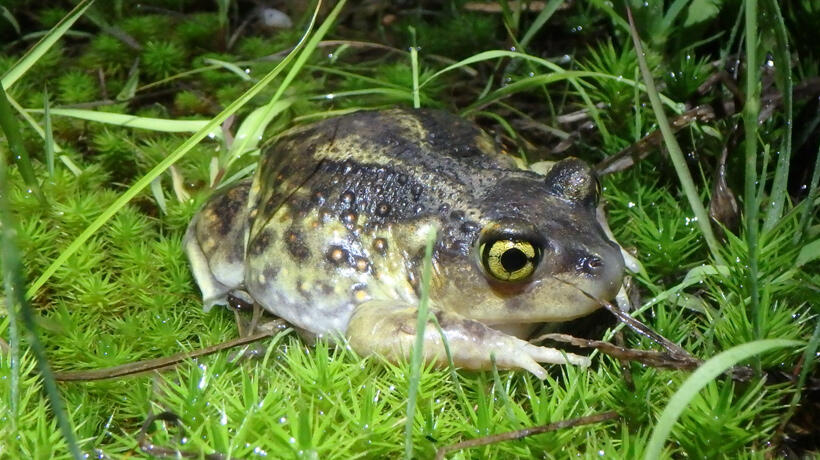- Division of Fisheries and Wildlife
- MassWildlife's Natural Heritage & Endangered Species Program
Media Contact
Media Contact, MassWildlife

Video: Introduced spadefoot population breeds for the first time
Skip this video Introduced spadefoot population breeds for the first time.Eastern spadefoot (Scaphiopus holbrookii) is a toad-like amphibian that occurs at the northern limit of its geographic range in southern New England. A regionally imperiled species, it is state-listed as threatened in Massachusetts and endangered in both Connecticut and Rhode Island. Its conservation is an especially high priority in the Connecticut Valley region of Massachusetts, where centuries of human activity have altered habitat so extensively that only three local populations are believed to remain. That number may now be four, as MassWildlife recently confirmed breeding activity for the first time at the site of its experimental population introduction at the Southwick Wildlife Management Area (WMA).
With financial support from the Massachusetts Outdoor Heritage Foundation and its partnership with Sanofi Genzyme, MassWildlife’s Natural Heritage and Endangered Species Program (NHESP) began its endeavor to establish a new population of eastern spadefoot approximately 6 years ago. Identifying an appropriate site was complicated and required careful consideration of many ecological and operational factors. Eastern spadefoot has strict habitat requirements, not all of which are well understood.
First, the species requires loose or friable soils (sand and fine loams), as it lives most of its life underground and depends on use of a small, spade-like appendage on its hind feet to burrow downward into the soil column. Second, spadefoots require vernal pools in which to breed and deposit eggs. But not just any vernal pool will do—only those that tend to hold water for a few weeks at a time seem to be used.
Ultimately, the Southwick WMA was chosen as the site of the spadefoot introduction, as it appeared to have suitable soils and provide other essential benefits. However, vernal pools were absent and would need to be constructed. During summer 2015, MassWildlife partnered with the Southwick Department of Public Works and students at Westfield State University and Bristol County Agricultural High School (BCAHS) to build three pools. Pool function was monitored the following year to help ensure suitability for spadefoot reproduction, and translocations of eggs and tadpoles from a carefully chosen donor population commenced in 2017.
Eggs and tadpoles from the donor population were introduced directly to pools in 2017 and 2018. In addition, both the NHESP and BCAHS students captive-reared some eggs during 2017–2019 to release as mature tadpoles and young juvenile spadefoots. That practice, termed “headstarting”, is a supplemental strategy to help boost survival rates.
In southeastern states, where the climate supports a longer feeding season, eastern spadefoots reach sexual maturity in approximately 2 years. However, the cooler climate of New England is believed to limit feeding opportunities and delay maturity by an additional year or more. Therefore, determining an outcome of the introduction effort at Southwick would take some patience. Optimism was challenged during the past several years when surveys failed to detect surviving spadefoots, but then again, spadefoots are rather notorious for being elusive.
This year, rains during late spring and early summer sparked some hope for recovery from recent droughts, and the arrival of Tropical Storm Elsa on July 9 motivated spadefoot monitors regionwide to visit their sites with the possibility of a late-season breeding event in mind. NHESP Conservation Scientist Jacob Kubel went to the Southwick WMA with a primary objective to confirm that at least some spadefoots had survived to adulthood and stayed on the site. What he found was even better: spadefoot tadpoles in one pool, followed by at least 30 breeding adults in another. Eggs and recently hatched tadpoles were confirmed at the latter pool 2 days later.
“It was a big night for the project,” said Kubel, “and these early results give us hope that it will be feasible to regain some lost ground in New England through active management.”
Kubel does caution that years of additional study will be needed to determine whether the Southwick WMA spadefoot population has a good chance of being self-sustaining. However, the number of breeding adults observed earlier this month is a very encouraging sign. Biologists throughout the region anxiously await results of several population introduction, pool restoration, and habitat augmentation efforts in Massachusetts, Connecticut, and Rhode Island. With additional data from a variety of sites and management strategies, the states and their partners will be in better position to identify and fine-tune effective approaches to restore and maintain populations of eastern spadefoot across suitable portions of the New England landscape.

